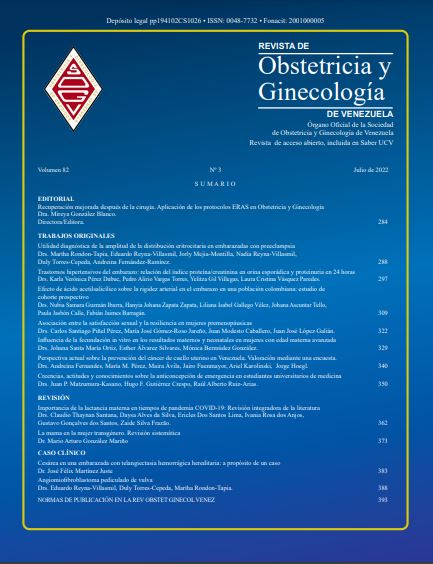Cesárea en una embarazada con telangiectasia hemorrágica hereditaria: a propósito de un caso
Palavras-chave:
Telangiectasia Hemorrágica Hereditaria, Síndrome de Rendu-Osler-Weber, Anestesia Espinal, CesáreaResumo
Las gestantes con telangiectasia hemorrágica hereditaria o síndrome de Rendu-Osler-Weber presentan un empeoramiento de su enfermedad debido a los cambios hemodinámicos del embarazo, con un aumento de la morbimortalidad. El manejo multidisciplinario de estas pacientes junto con un adecuado estudio preoperatorio, permite establecer un plan anestésico individualizado para el momento del parto. La anestesia espinal representa una opción adecuada en aquellos casos en que sea posible su realización.
Downloads
Referências
Govani FS, Shovlin CL. Hereditary haemorrhagic telangiectasia: a clinical and scientific review. Eur J Hum Genet. 2009; 17:860-871. DOI: 10.1038/ejhg.2009.35.
Della Vella B, Unfer V, Nania C, Borgia ML, Saraceno A, Minozzi M. Hereditary haemorragic teleangectasia and pregnancy: case report. Eur Rev Med Pharmacol Sci [Internet]. 2012 [consultado noviembre de 2021];16(7):986-989. Disponible en: https://www.europeanreview.org/wp/wp-content/uploads/1429.pdf
Robert F, Desroches-Castan A, Bailly S, Dupuis-Girod S, Feige JJ. Future treatments for hereditary hemorrhagic telangiectasia. Orphanet J Rare Dis. 2020; 15(1):4. DOI: 10.1186/s13023-019-1281-84.
Shovlin CL, Guttmacher AE, Buscarini E, Faughnan J F MARTÍNEZ JUSTE 386 ME, Hyland RH, Westermann CJ, et al. Diagnostic criteria for hereditary hemorrhagic telangiectasia (Rendu-Osler-Weber syndrome). Am J Med Genet. 2000;91(1):66-67. DOI: 10.1002/(sici)1096-8628(20000306)91:1<66::aid-ajmg12>3.0.co;2-p.
El Shobary H, Schricker T, Kaufman I. Anaesthetic management of parturients with hereditary haemorrhagic telangiectasia for caesarean section. Int J Obstet Anesth. 2009; 18:176-181. DOI:10.1016/j.ijoa.2008.12.001
Begbie ME, Wallace GM, Shovlin CL. Hereditary haemorrhagic telangiectasia (Osler-Weber-Rendu syndrome): a view from the 21st century. Postgrad Med J. 2003;79(927):18-24. DOI: 10.1136/pmj.79.927.18.
Kazma JM, van den Anker J, Allegaert K, Dallmann A, Ahmadzia HK. Anatomical and physiological alterations of pregnancy. J Pharmacokinet Pharmacodyn. 2020; 47(4):271-285. DOI:10.1007/s10928-020-09677-1.
Shovlin CL, Sodhi V, McCarthy A, Lasjaunias P, Jackson JE, Sheppard MN. Estimates of maternal risks of pregnancy for women with hereditary haemorrhagic telangiectasia (Osler–Weber–Rendu syndrome): suggested approach for obstetric services. BJOG. 2008;115:1108-1115. DOI: 10.1111/j.1471-0528.2008.01786.
Cottin V, Plauchu H, Bayle JY, Barthelet M, Revel D, Cordier JF. Pulmonary arteriovenous malformations in patients with hereditary hemorrhagic telangiectasia. Am J Respir Crit Care Med. 2004;169(9):994-1000. DOI: 10.1164/rccm.200310-1441OC.
Mac Sweeney C, Connolly P, Brady AB, Cafferkey A. Anaesthetic management of a parturient with hereditary haemorrhagic telangiectasia (HHT) and pulmonary haemorrhage requiring urgent caesarean section. BMJ Case Report. 2020; 13:e231120. DOI:10.1136/bcr-2019-231120
Swietlik E, Doboszynska A. Recurrence of arterio-venous malformations with life-threatening complications in a pregnant woman with hereditary teleangiectasia. J Physiol Pharmacol [Internet]. 2008 [consultado en noviembre de 2021];59(6):683-88. Disponible en: https://www.jpp.krakow.pl/journal/archive/12_08_s6/pdf/683_12_08_s6_article.pdf
de Gussem EM, Lausman AY, Beder AJ, Edwards CP, Blanker MH, Terbrugge KG, et al. Outcomes of pregnancy in women with hereditary hemorrhagic telangiectasia. Obstet Gynecol. 2014;123(3):514-520. DOI: 10.1097/AOG.0000000000000120.
Hirsch NP, Child CS, Wijetilleka SA. Paraplegia caused by spinal angioma-possible association with epidural analgesia. Anesth Analg [Internet]. 1985 [consultado en diciembre de 2021]; 64:937-940. Disponible en: https://journals.lww.com/anesthesia-analgesia/Citation/1985/09000/Paraplegia_Caused_by_Spinal_Angioma_Possible.15.aspx
Abut Y, Erkalp K, Bay B. Spinal subdural hematoma: a pre-eclamptic patient with a spinal arteriovenous malformation. Anesth Analg. 2006;103(6):1610. DOI: 10.1213/01.ane.0000246274.96202.c7.
Faughnan ME, Mager JJ, Hetts SW, Palda VA, Lang-Robertson K, Buscarini E, et al. Second International Guidelines for the Diagnosis and Management of Hereditary Hemorrhagic Telangiectasia. Ann Intern Med. 2020;173(12):989-1001. DOI: 10.7326/M20-1443.
Kamimura Y, Nakanishi T, Boku Sato A, Kako E, Tanaka M, Sobue K. Anesthetic considerations for cesarean delivery in a parturient with hereditary hemorrhagic telangiectasia: a case report. JA Clin Rep. 2021;7(1):19. DOI: 10.1186/s40981-021-00420-4.
Bick RL. Hereditary hemorrhagic telangiectasia and disseminated intravascular coagulation: a new clinical syndrome. Ann N Y Acad Sci. 1981;370(1):851-854. DOI:10.1111/j.1749-66321981.tb29791.
Javedan H, Naz N, Tandon M, Ayala J. DIC as a complication of HHT or Osler-Weber-Rendu syndrome. Am J Gastroenterol [Internet]. 2007 [consultado en diciembre de 2021];102:365. Disponible en: https://journals.lww.com/ajg/Fulltext/2007/09002/DIC_as_a_Complication_of_HHT_or_Osler_Weber_Rendu.673.aspx
LaBranche J, Nahirniak S, Vethanayagam D. Common bleeding disorders affecting individuals with hereditary hemorrhagic telangiectasia. Angiogenesis. 2015; 18(4):553-53. DOI:10.25011/cimv39i1.26324
Lomax S, Edgcombe H. Anesthetic implications for the parturient with hereditary hemorrhagic telangiectasia. Can J Anaesth. 2009;56(5):374-384. DOI: 10.1007/s12630-009-9076-z.

